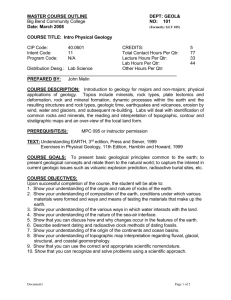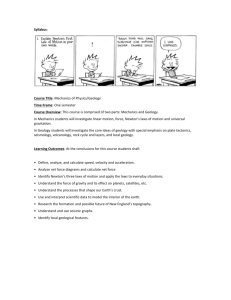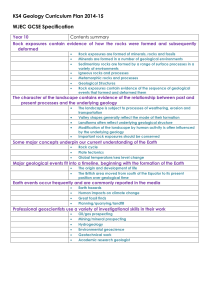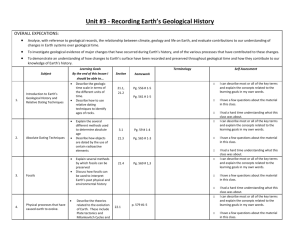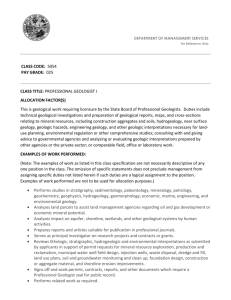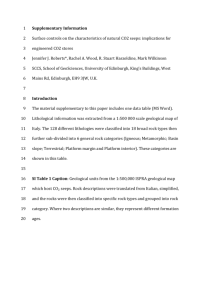Geology12
advertisement
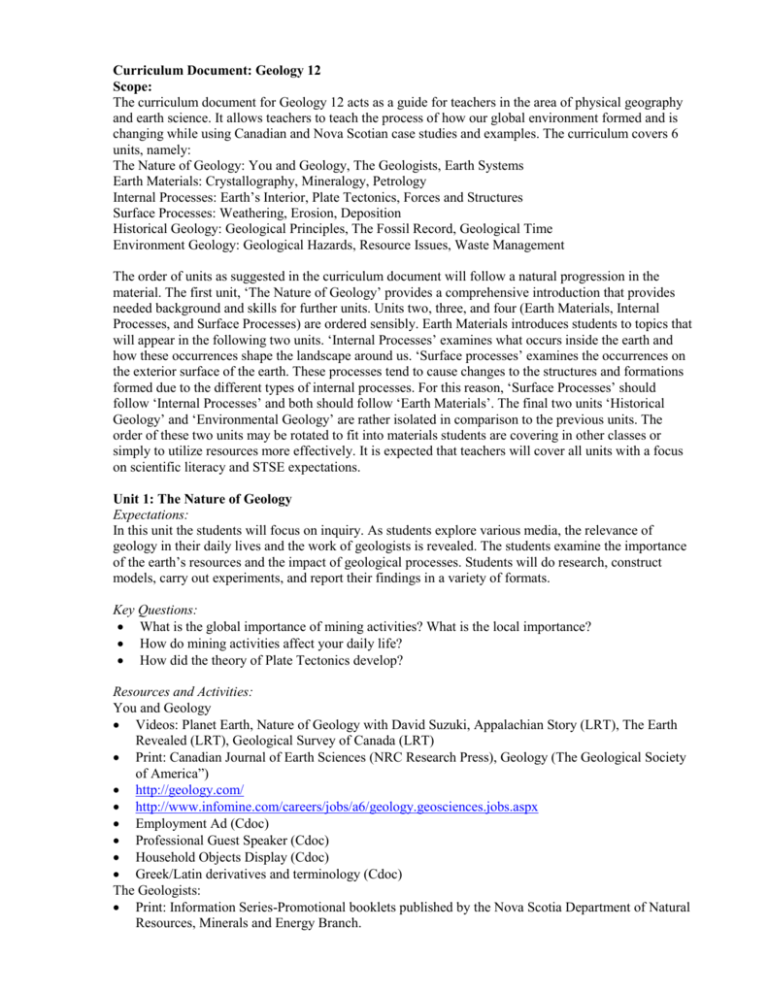
Curriculum Document: Geology 12 Scope: The curriculum document for Geology 12 acts as a guide for teachers in the area of physical geography and earth science. It allows teachers to teach the process of how our global environment formed and is changing while using Canadian and Nova Scotian case studies and examples. The curriculum covers 6 units, namely: The Nature of Geology: You and Geology, The Geologists, Earth Systems Earth Materials: Crystallography, Mineralogy, Petrology Internal Processes: Earth’s Interior, Plate Tectonics, Forces and Structures Surface Processes: Weathering, Erosion, Deposition Historical Geology: Geological Principles, The Fossil Record, Geological Time Environment Geology: Geological Hazards, Resource Issues, Waste Management The order of units as suggested in the curriculum document will follow a natural progression in the material. The first unit, ‘The Nature of Geology’ provides a comprehensive introduction that provides needed background and skills for further units. Units two, three, and four (Earth Materials, Internal Processes, and Surface Processes) are ordered sensibly. Earth Materials introduces students to topics that will appear in the following two units. ‘Internal Processes’ examines what occurs inside the earth and how these occurrences shape the landscape around us. ‘Surface processes’ examines the occurrences on the exterior surface of the earth. These processes tend to cause changes to the structures and formations formed due to the different types of internal processes. For this reason, ‘Surface Processes’ should follow ‘Internal Processes’ and both should follow ‘Earth Materials’. The final two units ‘Historical Geology’ and ‘Environmental Geology’ are rather isolated in comparison to the previous units. The order of these two units may be rotated to fit into materials students are covering in other classes or simply to utilize resources more effectively. It is expected that teachers will cover all units with a focus on scientific literacy and STSE expectations. Unit 1: The Nature of Geology Expectations: In this unit the students will focus on inquiry. As students explore various media, the relevance of geology in their daily lives and the work of geologists is revealed. The students examine the importance of the earth’s resources and the impact of geological processes. Students will do research, construct models, carry out experiments, and report their findings in a variety of formats. Key Questions: What is the global importance of mining activities? What is the local importance? How do mining activities affect your daily life? How did the theory of Plate Tectonics develop? Resources and Activities: You and Geology Videos: Planet Earth, Nature of Geology with David Suzuki, Appalachian Story (LRT), The Earth Revealed (LRT), Geological Survey of Canada (LRT) Print: Canadian Journal of Earth Sciences (NRC Research Press), Geology (The Geological Society of America”) http://geology.com/ http://www.infomine.com/careers/jobs/a6/geology.geosciences.jobs.aspx Employment Ad (Cdoc) Professional Guest Speaker (Cdoc) Household Objects Display (Cdoc) Greek/Latin derivatives and terminology (Cdoc) The Geologists: Print: Information Series-Promotional booklets published by the Nova Scotia Department of Natural Resources, Minerals and Energy Branch. Software: An introduction to Topographic Maps (LRT), Science Discovery-Science Sleuths (LRT) Video: The Earth Scientists (LRT), Geological Survey of Canada (LRT), Living Machine: Plate Tectonics (LRT), Born of Fire (National Geographic Society), Geoscience Mapping, Living Machine: plate tectonics http://www.infomine.com/careers/jobs/a6/geology.geosciences.jobs.aspx http://www.wisegeek.com/what-is-a-field-geologist.htm http://www.cspg.org/ http://www.ccpg.ca/pgeoreg/index.php?lang=en Plate Tectonics Model (Cdoc) Professional Interview (Cdoc) Oral Presentation of Geologist position (Cdoc) Earth Systems. Print: The Practical Geologist (Dixon & Bernor) Video: Lake that fell into the Earth (LRT), Blue Planet: Circulation of the Oceans (LRT), Climate Puzzle: The Atmosphere (LRT), Gifts from the Earth: Energy Resources (LRT) http://www.classzone.com/books/earth_science/terc/content/investigations/es0602/es0602page02.cf m http://www.classzone.com/books/earth_science/terc/content/investigations/es0103/es0103page02.cf m Climatic change experiment (Cdoc) Model of changes in an Earth System (Cdoc) Directory listings of Geological information (Cdoc) Non-renewable resources/recycling/renewable resources debate Human Impact article (Cdoc) Safety Considerations: Video Management; Check with admin for rules; classroom management; review appropriate behaviour for guest speaker. Unit 2: Earth Materials: Expectations: Students will examine Earth materials in “Hands-on, minds-on” investigations. Students are expected to make many first-hand observations of prepared specimens as they identify the physical and chemical characteristics of common minerals and classify them. Students are expected to become familiar with these rock-forming minerals and the various rock textures before they attempt to classify rock specimens. The investigations in this unit will lead to an awareness of how the characteristics of a rock specimen allow geologists to infer its origin. Key Questions: Why is it said, “ The silicon tetrahedron is the most important building block in the earth’s crust”? What are the various characteristics that are used to classify minerals? Explain why and how. Explain the processes, which create sedimentary, volcanic and metamorphic stratigraphy. Resources and Activities: Crystallography Print: Field Guilds to Rocks and Minerals Software: Geology explorer (LRT) Video: Minerals: The Materials of the Earth (LRT), The Rock Cycle (LRT), Chemistry on Earth (LRT) Crystal lattice models, microcrystal study kits, macrocrystal growth kids, stereoscopic microscopes, hand lenses, selected mineral/crystal/rock specimens http://webmineral.com/crystall.shtml http://www.rockhounds.com/rockshop/xtal/ Classification of earth materials (Cdoc) 3-D model of crystal systems (Cdoc) Crystal form models Silicon Tetrahedron article (Cdoc) Mineralogy Print: Promotional booklets published by Nova Scotia Department of Natural Resources, Minerals and Energy Branch; Geological Highway Map of Nova Scotia (Nova Scotia Department of Natural Resources, Minerals and Energy Branch); Elsevier’s Minerals of the World Poster Video: Mineral Vignettes (LRT); Mineral Wealth of Atlantic Canada (LRT); Gifts from the Earth: Mineral Resources (LRT); The Rock Cycle (LRT) Selected mineral specimens, streak plates, glass plates, ultraviolet lamp, dilute hydrochloric acid, magnifiers http://webmineral.com/ http://www.gov.ns.ca/natr/meb/pdf/memoir08.asp http://www.gov.ns.ca/natr/meb/links/modblinks.asp Mineral Characteristics lab (Cdoc) Travel brochure (Cdoc) Petrology: Print: Field Guilds to Rocks and Minerals; Promotional booklets published by the Nova Scotia Department of Natural Resources, Minerals and Energy Branch; Geological Highway Map of Nova Scotia (Nova Scotia Department of Natural Resources, Minerals and Energy Branch); Elsevier’s Mineral and Rock Table Video: The Rock Cycle (LRT); The Rock Cycle (Marlin)(LRT); Fossil Story (LRT), Volcanism (LRT) Selected rock specimens, magnifiers, stereoscope microscope, rock cycle model, rock hammers, safety goggles http://www.gtwist.ca/Petrology/volcanicpetrology.html Classification of rock specimens (Cdoc) Rock Transitions article (Cdoc) Geology game (Cdoc) Rock type under home (Cdoc) Safety Considerations: Microscope handling and care; Field trip safety; Sample handing procedures; General lab safety procedures; WHMIS review. Unit 3: Internal Processes Expectations: The students are expected to develop their decision making abilities as they explore print and other media to understand the origins of the Earth’s structures. Students will do research, construct models and diagrams and report their findings in a variety of formats while discovering how science has determined the internal structure of the earth and how technology has helped in revealing the layered structure of the interior. Key Questions: Why is understand S-wave and P-wave velocities necessary for locating an epicenter? Is Seattle/Vancouver or Halifax more likely to experience a strong earthquake? Why? Explain the events leading to the formation of Pangea Explain the structural processes that lead to the formation of a mineral occurrence in Nova Scotia (ex: Meguma Gold) Resources and Activities: Earth’s Interior Video: Earth’s Interior (LRT); Earth’s Structure (LRT); Volcanism (LRT); New World Below (LRT); Lithoprobe: Probing the Earth (LRT) Earth Quake Watch kits; Seismograph model; Mid-Atlantic ridge maps; Relief globes http://www.learner.org/interactives/dynamicearth/ http://scign.jpl.nasa.gov/learn/plate1.htm Physical model (Cdoc) Earth quake predictions (Cdoc) “Solid Earth” challenge (Cdoc) Review drill core logs Earth quake proof house (Cdoc) Plate Tectonics Print: Investigations in Earth Science (Beckway and Young); Dictionary of Geological Terms (Prinz, Harlow and Peters); The Restless Earth (Calder); Mid Atlantic ridge map; Geologic HWY map of Nova Scotia Software: The Theory of Plate Tectonics (LRT) Video: Plate Dynamics (LRT); Mountain Building and Growth of Continents (LRT); Living Machine-Plate Tectonics (LRT); Plate Tectonics-The Puzzle of the Continents (LRT) Ocean floor models; Terrestrial; Sea floor spreading kits; Earth Quake watch kit http://www.pbs.org/wgbh/aso/tryit/tectonics/ http://www.teachersdomain.org/resource/ess05.sci.ess.earthsys.lp_platetectonics/ Demonstrate how the theory evolved along with opposing theories. 100 million year old map (Cdoc) Debate plate tectonics (Cdoc) Forces and Structures Print: The Geological Highway Map of Nova Scotia Video: Faulting and Folding (LRT); The Rock Cycle (LRT) Geologic block model materials; Plasticine and cutting tools; Landform models; Geology demonstration kit; Geologic maps; Compasses and clinometers http://www.gov.ns.ca/natr/meb/pdf/bull07.asp http://www.pbs.org/wnet/savageearth/hellscrust/index.html Geologic block model interpretation (Cdoc) Field Trip-identification of folds, faults, and other alterations (Cdoc) Form block model from geologic history (Cdoc) Structural features vs mineral occurrences Safety Considerations: Classroom management; lab safety review; Instructions on how to handle equipment properly; Religious beliefs; Fieldtrip permission and safety procedures. Unit 4: Surface Processes Expectations Study how the processes of weathering, erosion, transportation, and deposition cause visible changes on the earth’s surface. Students will examine the roles of precipitation, waves, glaciers, wind, and other factors in these processes. The information will be applied to landscapes in the student’s home region. Key Questions In what ways can weathering occur? How have human activities influenced this process? What is the relationship between soils and weathering? What is the importance of soil? What are the characteristics of eroded landscapes and how can they be recognized? What processes contribute to erosion and how do they function? What human actions have contributed to this problem and how can this damage be reduced? How does particle size contribute to the patterns of deposition? Resources and Activities: Video:http://serc.carleton.edu/NAGTWorkshops/geomorph/visualizations/erosion_deposition.html Photo Gallery: http://science.nationalgeographic.com/science/photos/weathering-erosiongallery.html#/sand-tufa_1179_600x450.jpg Video: http://video.yahoo.com/watch/2170360/6867068 Aerial photographs of weathered and eroded landscapes Field trips to shorelines, meandering streams, and other eroding landscapes Glacier video: http://environment.nationalgeographic.com/environment/global-warming/extremeice-survey-article.html Topographic and highway maps (Cdoc) Videos: Waves, Beaches, and Coasts; Ocean Mapping; The Rock Cycle (Cdoc) Simluate examples of biological, chemical, and physical weathering. (Cdoc) Examination of soil and mineral samples. (Cdoc) Safety Considerations: Follow instructions at field locations. Obtain permission from administration. Review of WHMIS lab safety procedures Unit 5: Historical Geology Expectations: Students will form connections between the evolution of geological knowledge with the evolution of knowledge in all scientific disciplines. Acquire knowledge of the guiding principles of geology, the theory and method of the fossil record, as well as the concept of geological time and dating. Key Questions Based on the laws and principles examined, can these formations be dated in relation to one another? How does fossil formation occur and how can these fossils be dated? What do the fossils represent and how do they inform the field of biology? What is the difference between relative and absolute dating? How is radioactive decay used in this context? Resources and Activities: Geological Principles Rock Cycle Video: http://magma.nationalgeographic.com/ngexplorer/0605/quickflicks/ UC Davis Podcasts – Uniformitarianism Photos of rock strata Videos: Faulting and Folding, The Rock Cycle, The Lake that Fell to Earth (Cdoc) Prepare posters explaining geological processes related to uniformitarianism. (Cdoc) The Fossil Record Fossil Formation Video: http://www.pbs.org/wgbh/evolution/library/04/3/l_043_01.html Fossil Game: http://www.rom.on.ca/programs/activities/fossils/game.php Video: http://onf-nfb.gc.ca/sg/100393.pdf Museums Nova Scotia: http://museum.gov.ns.ca/fossils/ Field trips to areas rich in fossils such as Arisaig, Joggins, or the Sydney Coalfields Videos: Fossil Story, Geoscience Mapping, Offshore Oil and Natural Gas, Mineral Vignettes. (Cdoc) Field guides for fossil identification, highway maps (Cdoc) Geological Time The Dating Game: http://www.pbs.org/wgbh/nova/first/radiocarbon.html United States Geological Survey: http://pubs.usgs.gov/gip/geotime/radiometric.html Create isotope decay curves and calculate relative ages of samples. (Cdoc) Videos: The Science of Change, Appalachian Story, The Recent Ice Age Safety Considerations: Extra time if students are creating model fossils. Ensure students treat fossils with respect and leave them in place. Realize that locations where one can observe multiple rock strata may not be stable. Follow instructions at field locations. Obtain permission from administration. Unit 6: Environmental Geology Expectations Recognize that human interaction with the physical world plays a major role in changing the environment. Become aware of how human societies are changed and shaped by their external physical environment. Study how this relates to the major themes of geological hazards, resource issues, and waste management. Students will apply this knowledge to real-life situations. Key Questions What geological hazards can affect humans and how do they affect human settlements? How can the effects of these hazards be mitigated? What actions would you take? What are the different types of resources and are they renewable or non-renewable? What can be done to conserve resources? What is the resource usage of the average Canadian? Why do humans produce so much waste and how can this be reduced? What management strategies can be employed to deal with waste that has already accumulated (possibly connecting this to specific cases such as the Sydney Tar Ponds)? Resources and Activities: Geological Hazards Earthquake videos: http://video.nationalgeographic.com/video/player/environment/environmentnatural-disasters/earthquakes/earthquake-101.html Google Earth: Earthquake and volcano layers Landslide videos: http://video.nationalgeographic.com/video/player/environment/environmentnatural-disasters/earthquakes/earthquake-101.html United States Geological Survey: http://www.usgs.gov/ Geological Survey of Canada: http://gsc.nrcan.gc.ca/index_e.php News articles on emerging disasters from sources such as CBC, BBC, and CNN Interviews with engineers and architects regarding building codes. Create models showing flood or landslide prevention. (Cdoc) Resource Issues Greenpeace: http://www.greenpeace.org/international/en/campaigns/climate-change/coal/Miningimpacts/ De Beers Canada – Mining: http://www.debeerscanada.com/files_3/mining.php Environment Canada: http://www.ec.gc.ca/eau-water/default.asp?lang=En&n=6A7FB7B2-1 Tours of locations such as Cape Breton Miner’s Museum http://www.minersmuseum.com/ NS DNR Publications: Mineral and Energy Maps, Publications (Cdoc) Videos: Cohasset Project, Ground Water, Offshore Oil and Natural Gas. (Cdoc) Waste Management Tours or trips to locations such as the Sydney Tar Ponds http://www.tarpondscleanup.ca/ , a local landfill, recycling plant, or compost plant. Book: The Magic School Bus at the Waterworks News articles on past issues such as the Chernobyl Disaster from sources such as CBC, BBC, and CNN. Video: http://video.nationalgeographic.com/video/player/environment/going-greenenvironment/green-home-makeover/compost-gg.html Environmental Science Activities Kit (Cdoc) Composting kits, model landfill kits (Cdocs) Safety Considerations: Follow instructions at field locations. Obtain permission from administration. If on a trip to a waste disposal site, ensure that students do not touch anything. References Nova Scotia Geology Curriculum: Geology 12, Crown Copyright, Province of Nova Scotia, 2003. Science Safety Guidelines, Grades Primary – 12, Crown Copyright, Province of Nova Scotia, 2005.


